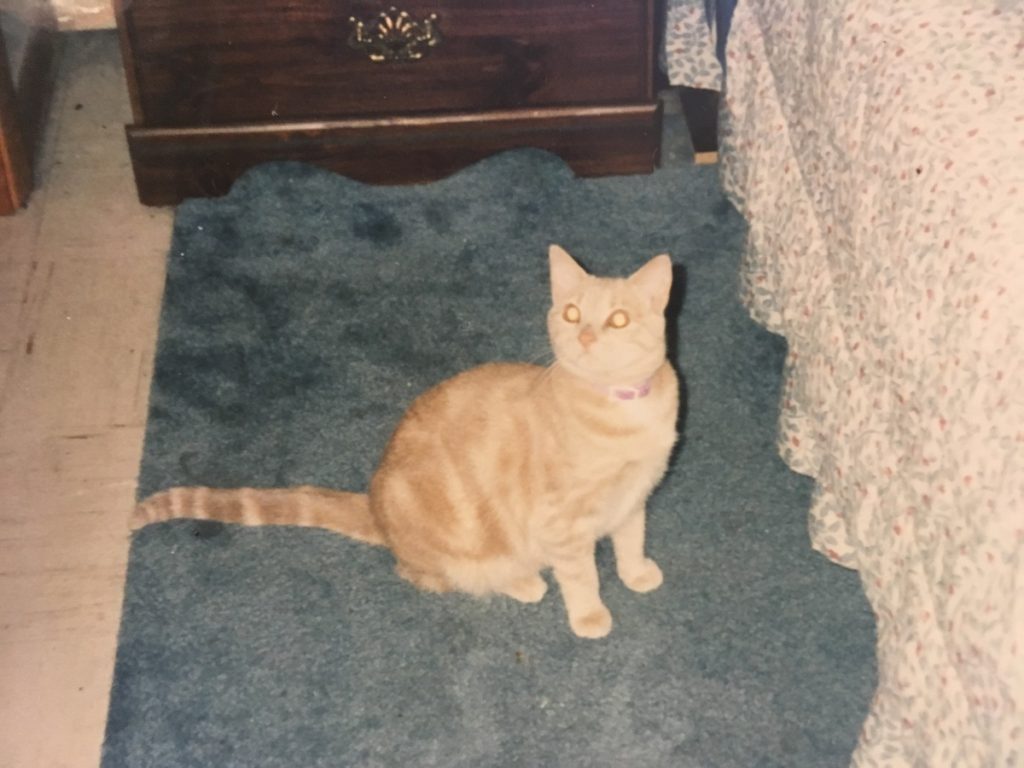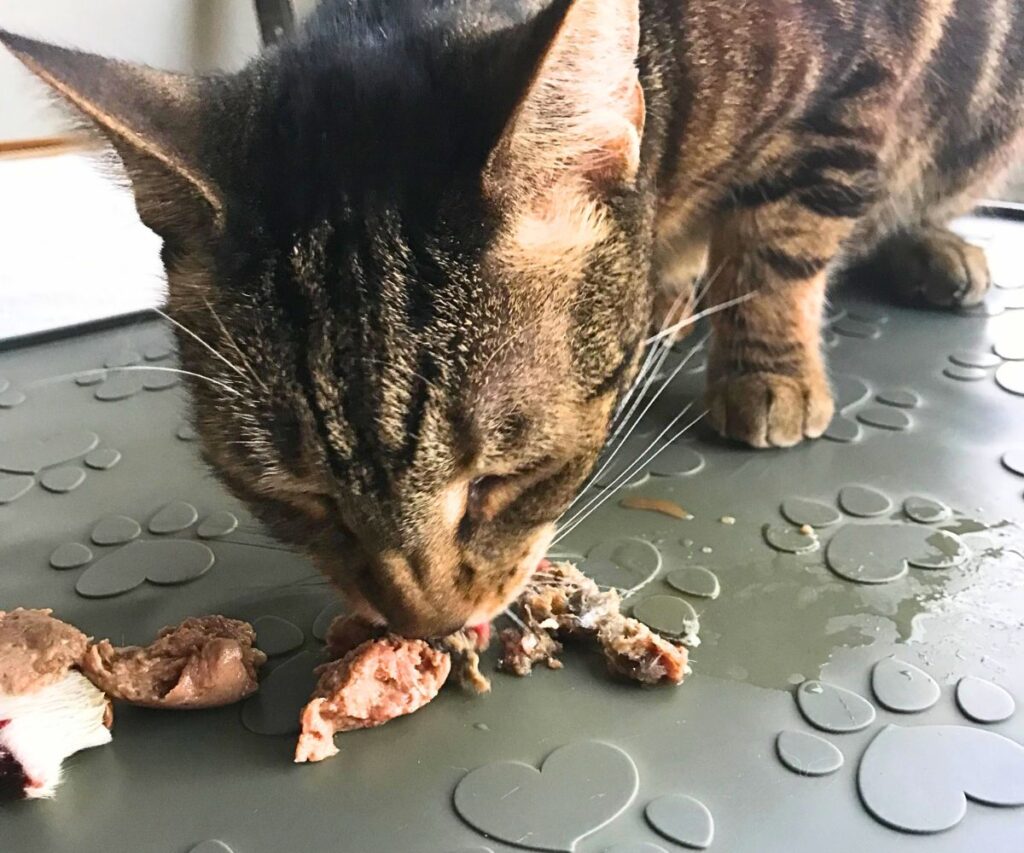A Cambridge University Press study shows minced or whole prey mice are better for cats than extruded dry diets. This is great news for cat parents!
Especially since more and more of us want to feed a biologically appropriate diet.
PS – If you’re ready to switch to a healthy raw diet, my Raw Feeding Blueprint is for you!
I’ve created the most supportive plan inside this course! Think, every week is planned out for you with printable trackers, 50+ balanced recipes to choose from, meal prep hacks, and so much more. If you’re ready to make your cat’s raw food at home, my Raw Feeding Blueprint course is for you!
My first cats ate whole prey mice
Whiskas and Chelsea were sisters. We adopted them at different times, but they were still able to grow up together.
We moved to a new house with a nice backyard in a small little community. So they were indoor/outdoor cats.
Whiskas and Chelsea definitely hunted prey. We’d see them tossing around mice in the yard.
And of course they left dead prey on our stoop.

They are saying, “Look! This is food!” It’s how mama cat teaches her babies how to hunt.
They ate whole prey outside, but we still left dry food out for them.
That’s what was normal for cats back then. Half the time raccoons stole the kibble.
But we still left kibble out for the cats.
Unfortunately, Chelsea died young at age 10 from diabetes. Whiskas was really hurt after that and didn’t come near us for a while.

After that, Whiskas became an indoor cat. I’ve talked about her in other videos. But she and I were really close.
Whiskas lived until about 16. But it wasn’t age that got her. She had a heart stroke.
And that was the “normal” for most of our cats growing up.
They ate dry food and had things like diabetes, kidney disease, cancer, obesity, shortened lives, and the list goes on.
But these health issues and shortened lives shouldn’t be normal for our cats. What should be normal?
Should our carnivore cats be eating whole prey indoors? Just like snakes do?
Whole prey mice for cats study
Well Pet Food Industry News posted about this. Typically they talk about processed food. So I’m glad they brought this up.
Pet Food Industry News mentions that cat parents want to feed a biologically-appropriate ancestral diet.
But it’s more normal for pet snakes to eat whole mice than it is for pet cats.
They talked about a study where cats were fed dry extruded diets and mice diets.
Let’s take a look at a study.

The British Journal of Nutrition published a study on Cambridge University Press featuring our wonderful domesticated cats.
15 cats were fed either whole mice or minced mice to see if food structure matters.
These cats were fed an extruded dry kibble diet for 10 days and then a mouse diet for 19 days.
The study found that food structure didn’t make a difference. The diet type is what’s more important.
Basically fresh vs extruded (highly processed and cooked).
So if you’re feeling weird about feeding whole mice you’re in luck! You can feed ground mice and get the same nutritional benefits.
Now of course you won’t get the dental cleaning benefits. But you don’t get that with dry or wet food either.

“The nutritional properties of dry extruded cat food differ considerably from animal prey such as mice.”
Basically, dry food is very high in plant-based ingredients. So that makes it high in plant fibers and undigested proteins that cats have no use for.
Since cats can’t use this nutrition, it goes to the intestine where the microbial population uses it.
This is important because the microbiome affects metabolic and immune responses. Essentially, gut health is important for overall health.
The study states that switching the cats from dry extruded diets to mice caused major shifts in the microbiome and a decrease in potentially harmful fermentation products.
So basically the microbiome populates with bacteria that favor carbohydrates instead of protein.
And this study references another study that shows kittens eating a high protein, low carb diet were healthier than those eating a moderate protein, moderate carb diet.
Nutrition from extruded dry diet vs mice
| Item | Extruded diet | Mice diet |
|---|---|---|
| Dry matter | 93.1 | 25.6 |
| Protein | 42.4 | 56.5 |
| Fat | 14 | 20.6 |
| Ash | 8.7 | 10.1 |
| Fiber | 2.2 | 0.6 |
| Starch/Carbs | 30.4 | 2.7 |
The biggest difference is the moisture content and the starches.
Dry matter means food without moisture. So this extruded diet was only 6.9% moisture. And mice are 74.4% moisture.
Moisture is super important for all of us since we’re all about 70% moisture.
The carb amount is insanely higher in the dry extruded diet. 30.4 in the extruded diet vs 2.7 in mice. That’s 10 times more!
Dr. Elizabeth Hodgkins owns a patent from a study she did among diabetic cats.
She switched the cats from a low protein, high carb diet to a high protein, low carb diet.
And she was able to put cats into remission! Most of the diabetic cats stopped needing insulin due to the diet changes.

The protein amounts are similar. But we have to remember that kibble is higher in plant-based protein.
And cats need animal-based protein since they are carnivores.
The study found that protein from mice is more digestible than protein from extruded kibble.
Interestingly, animal fiber from tissues such as hair, bone, cartilage, and skin are similar to plant fibers.
However, the fiber amount from prey is still significantly less compared to extruded diets.
The cats eating the mouse diet with less fiber still had firm feces.
And I can second that because Jericho’s poops are always well-formed and normal on his premade raw and whole prey diet.
Plus, animal fibers in prey such as mice can protect against harmful protein fermentation.
How you can feed whole prey
Want to feed whole prey too? The first step is to switch from dry/wet processed food to a premade raw diet. Check out how to transition cat food for help on that.
Yes, whole prey is natural. But your cat probably won’t recognize it as food if he has no fresh food in his diet.
Going from dry to whole prey is like going from addicting chips and candy to fresh filet mignon.
If you’re already feeding fresh food, check out my mouse cat food recipe to get started easily. This recipe is complete and balanced and uses ground mouse so the transition is easier! Then check out my whole prey recipe for cats.
Need help switching to raw?
Grab my Raw Feeding Blueprint and get the same plan that 564+ cat parents used to switch to a healthy raw diet easily and confidently. Plus 50+ balanced raw recipes, meal prep tips, and so much more!
